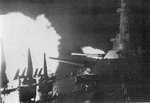....the DoY managed to hit the Scharnhorst 7 or 8 times. To achieve those 7-8 hits. One source I know of says the DoY expended 52 salvoes to achieve those hits, which would equate to 520 rounds. However, for the entire engagement, DoY only expended 443 14inch rounds, so in all probability some of those 52 salvoes were secondary only. Estimated ammunition expenditure 1947 to 1824 is around 240 rounds...
http://www.navweaps.com/Weapons/WNBR_14-45_mk7.htm said:During the early part of her action against Scharnhorst at the Battle of the North Cape on 26 December 1943, HMS Duke of York scored 31 straddles out of 52 broadsides fired and during the latter part she scored 21 straddles out of 25 broadsides, a very creditable gunnery performance. In total, Duke of York fired 450 shells in 77 broadsides. However, HMS Duke of York still fired less than 70% of her possible output during this battle because of mechanical and "errors in drill" problems.

